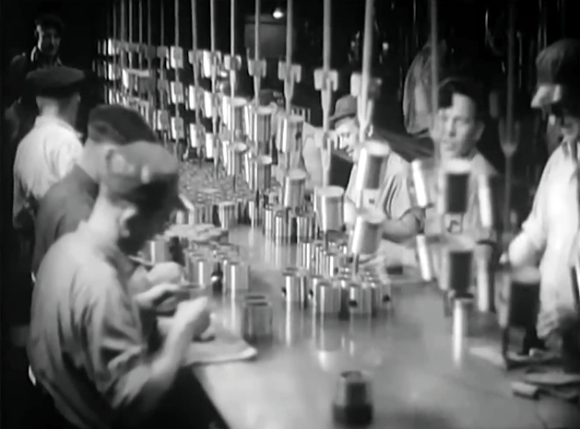
We usually shy away from calling things ‘magic’ in our features because, you know… science. But in the case of this Chevrolet manufacturing reel from 1936 the presentation is nothing short of an industrialized version of The Sorcerer’s Apprentice. Well, not in the sense of mischief, but in that there is almost no explanation and the way the footage is laced together you get the strong feeling that, at the time, this type of industrialization was magic; a modern marvel. The techniques and skills of each worked passed down from a master to an apprentice but virtually unknown to the general public.
The clip, which is also embedded below, starts off in the machine shop where mold makers are getting ready to go into assembly line production. From there it’s off to the foundry for part casting and then into the stamping plant where white-hot (perhaps red-hot, but black and white film) metal is shaped by man-mangling presses. The image above follows the cast, stamped, and machined parts onto the assembly line. We like seeing a room full of pistons being QA checked by hand using a width gauge and micrometer. The film continues through to the finished vehicle and we think you’ll agree there’s more than enough voyeuristic video here to overcome that lack of narration.
http://www.youtube.com/watch?v=VvAH-Yskyio
[Thanks Pretenda]
Retrotechtacular is a weekly column featuring hacks, technology, and kitsch from ages of yore. Help keep it fresh by sending in your ideas for future installments.















See Clarke’s Third Law: Any sufficiently advanced technology is indistinguishable from magic.
Robots are faster, more precise, don’t ask for benefits and don’t brag about union bullshit.
…and don’t buy cars.
indeed
Google is working on that. (probably because car manufacturers pays the most for search ads and since google, robots are the most avid internet consumers)
And that’s a perfectly good way to treat a robot.
How many unions have you been in?
Two. I agree with him.
Gee, do you remember when we used to make things in this country, I don’t.
I do. It was depressing though because I could tell it was coming to an end. I worked in a machine shop with 5 other guys that at it’s peak had 50 working in it. We had whole tool rooms abandoned at that factory. They just sat, empty, and idle. I’ve also done electronics fabrication in the USA too. Imagine that!
wacky soundtrack… I keep waiting for Peter Lorre to pop out from behind one of those giant wheels clutching a blood soaked dagger
Wagner (The Ring in this case) was widely used for everything till WWII. Since then his work is associated with The NAZI’s, fairly or not, and you get the occasion Ride of the Walkurie, as in Apocalypse Now, and opera house performances.
Pretty cool though. Boeing makes a 777 every week.
I’ve spent a few hundred hours in auto plants and parts plants in the last 2 years. Dozens of them. Big differences besides automation: parts tolerances are orders of magnitude better now, and have to be. All of the work is far safer than it used to be and often less unpleasant. Organization and coordination are highly developed. This is an advantage for speed and efficiency but a disadvantage for continued productivity when one failure can stop a plant.
and not 6 years after this film was released all that industrial might went into constructing the war machine that saw us through the European and Pacific theatres. We couldn’t hope to match that rapid turn around or mass production capability today.
It’s cool to watch stuff like this, but, man, did I cringe at all that unguarded machinery and unlimited number of pinch/crush points.
It was guarded by Humans.
Probably lubricated by the blood/fat of the previous workers, too.
Did you see how they made the crankshaft? Wow.
i love when you see a skilled person on the forge/hammer. It looks effortless but so skilled.
And in contrast, this is how they make a car nowadays:
http://www.treehugger.com/cars/how-its-made-tesla-model-s-electric-car-video.html
Much more automation and much newer technology, but the assembly line (or “assembly tree” as it might be) hasn’t otherwise changed.
Some of you might have noticed the ‘safety feature’ @ the 23:00 mark (approx).
Yep, those fellas were required to push on the two large buttons in front, to make the machine move. If both the workers didn’t press the two ‘safety’ buttons, then nothing!
It’s a simple, but very effective method of keeping your hands attached to oneself!
I’ll bet ya, they were awesome arm-wrestlers and better skilled than the ‘workers’ of today…
Science is magic, who are you kidding?
So much molten metal! Imagine telling those foundry workers that their grandchildren would be bringing huge lawsuits over coffee that was too hot.
As a barista at Starbucks, I like to think I carry on that tradition of hard-working craftsmanship… Room for cream, sir?
Yeah, that’s how it has been done. Amazing what you can do without sophisticated tooling. Forging crankshafts, carving connecting rods and quality control by listening to valves and bearings… But no magic, just old school fabbing…
Just wow. I didn’t expect the process to be so automated in the 30’s. Those riveting robots on the frame line look nearly like the welding robots of today. Of course they are much simple robots, but I figured it was a far more manual process in the 30’s.
Also impressed by the quality of the film. Notice that really long continuous take in the car roof pressing? Also notice those flying camera shots from the ceiling a few times. That was wild, expensive stuff back then.
Today there are still factories that make cars manually. Just not the mass-produced ones: http://channel.nationalgeographic.com/channel/videos/audi/
Oh those TV stations and their DRM’ed videos, they are so silly.
It is amazing how sophisticated the process was when you consider it was about 80 years ago.